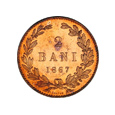The Order of „St. Sava”
Text: Tudor Martin; photo: Marius Amarie.
The National History Museum owns one of the most important collections of medals and decorations among all the museums in Romania, both as number and as the rarity of many distinctions in its patrimony. Among these, there are a few copies of the Serbian Order of “St. Sava”, which were awarded to some personalities, such as Queen Marie of Romania, General Constantin Amza Ștefănescu, the doctor Constantin I. Istrati and the politician Mihai Popovici from the Peasants’ Party. Out of all the decorations of this kind owned by the museum, the one awarded to Queen Marie of Romania is the most spectacular, as it is made of gold and turned into a genuine jewel, encrusted with diamonds and sapphires.
The Order of “St. Sava” was founded in 1883 by King Milan I Obrenovici and was one of the decorations awarded by the neighboring country between 1883 and 1941/1945. At first, this distinction was awarded only to the civilians for special achievements in sciences and arts and for services to the Church, the Royal House and the state, but, since 1914 – the year when World War I broke out – the servicemen have also been rewarded with this order. Moreover, it was a distinction awarded to women and foreign citizens.
As most European orders, this also had five ranks/classes, the most important being the one of Grand Cross/I, followed by the one of Grand Officer/II, Commander/III and Officer/IV, the last one being the one of Knight or the 5th class. The common distinctions, produced for being awarded en masse, had the first classes gilded, no matter if they were made of silver or of a common metal alloy, but some personalities were awarded decorations made of gold and encrusted with precious stones, which were ordered and produced especially for them.
As it was a decoration awarded during the reign of some kings from two different dynasties, its appearance suffered some modifications. The first model, made during the reign of King Milan Obrenovici had on the obverse the image of Saint Sava, dressed in red garments, whereas the reverse displayed the crowned monogram of the king. After the instauration of the Karagheorghevici dynasty (1903), the monogram on the reverse was replaced with the year when the decoration was established - 1883, but there are distinctions with the year 1882 (when the kingdom was proclaimed). The third and last model, made since 1921 (the beginning of King Alexander I’s reign), depicted the saint in green garments, whereas the reverse was marked with the year 1883. Until World War I broke out, most of the decorations were produced by Austrian companies, such as G. A. Schied in Vienna, and since 1915 they have been made by several French, Swiss and local companies, among which there are Arthus Bertrand in Paris, Huguenin Frères in Le Lôcle and Fran Sorlini in Varaždin.
The insignia of the order have the shape of a Maltese cross with white enameled arms on the inside and with blue edges. The arms have a globule at each tip, and between them is placed a crowned bi-cephalous eagle that has the coat of arms of the Serbian state. To the upper arm of the cross is attached an ornament in the shape of a lily flower, to which a royal crown is attached, with a ribbon ring on top. On the obverse, in the center of the sign, Saint Sava is represented, dressed in red or green clothes (depending on the type of decoration), blessing with the right hand and holding a bishop’s staff in the left, at the first two models, and holding a church fan in the right hand and an open book in the left, in the case of the latest model. The proverb that appears on the blue band that surrounds the central representation is “Through work man is glorified”. In the case of the reverse, there are several types of central medallions: the first model displays the crowned monogram of the king (MI), the second model may have the years 1882 or 1883, and on the last model there is only 1883. The blue band on this side is identical for all the models, being decorated with a laurel wreath. The ribbon of this order was white with two blue stripes at the edges.
The plate/star, granted only in the case of the first two grades (Great Cross and Great Officer), has the form of a star with eight bunches of rays, on which the obverse of the sign was applied. Its reverse is smooth, but the clamping needle usually contains the name of the manufacturer, pins and markings.
This decoration bears the name of Saint Sava (Rastko Nemanja, ca. 1175-1236), son of the Serbian Prince Stephen Nemanja. Saint Sava was the first archbishop of the autocephalous Serbian Orthodox Church and is considered its founder. It should not be mistaken for another Serbian distinction that bears the same name, created in 1985, which is still awarded by the Serbian Orthodox Church.
The decorations presented are the following: 37455 a-c (granted to Queen Marie, degree of Great Cross, model II, gold, diamonds, sapphire, enamel), 67377 a-b (granted to the politician Mihai Popovici, degree of Great Cross, model III, gilded silver, silver, enamel), 167960-167961 (granted to Constantin I. Istrati, Grand Officer, model II, gilded silver, silver, enamel), 325058-325059 (High Officer grade, model III, gilded silver, silver, enamel), 324163 (degree of Commander, model I, gilded silver, enamel), 324575 (Officer rank, model II, gilded silver, enamel), 86891 (granted to Colette Lahovary Plagino - member of the National Red Cross Society of Romania, Officer rank, model III, gilded silver, enamel) and 126524a (granted to Cristache Dimitrescu - head of the Royal Palace Post Office, Knight's degree, model III, silver, enamel).





















